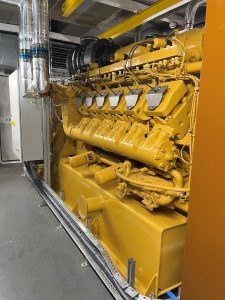Finning UK & Ireland has completed a challenging Combined Heat and Power (CHP) upgrade at Norfolk and Norwich University Hospital, a 1200 bed Private Finance Initiative (PFI) NHS hospital. Working closely with the hospital FM provider Serco, on behalf of Octagon Healthcare, the team was able to overcome strict space limitations while maintaining 24/7 operations at the busy hospital.
 Having reached the end of its lifecycle, the previous Cat CHP unit, installed by Finning over 20 years ago, was replaced with a CG170-12 12-cylinder engine. Chosen for both its thermal and electrical properties, the new natural gas engine produces 1MW of electrical power and recovers heat from exhaust gases to reduce onsite boiler usage, making it an economic and efficient solution that supports the NHS’s drive for carbon reduction initiatives coming with the additional benefit of a hydrogen ready engine.
Having reached the end of its lifecycle, the previous Cat CHP unit, installed by Finning over 20 years ago, was replaced with a CG170-12 12-cylinder engine. Chosen for both its thermal and electrical properties, the new natural gas engine produces 1MW of electrical power and recovers heat from exhaust gases to reduce onsite boiler usage, making it an economic and efficient solution that supports the NHS’s drive for carbon reduction initiatives coming with the additional benefit of a hydrogen ready engine.
Roger Perkins, Project Manager for Serco Group Plc., explained, “Space restrictions on site meant that we needed a new generator that could fit the existing acoustic enclosure, and for the complete CHP system to remain within the same footprint, and importantly, integrating into the existing heating and electrical infrastructure.”
With all work taking place in and around the hospital’s busy loading bay, the upgrade work was made even more challenging due to crucial health and safety considerations alongside the need to maintain 24/7 hospital operations.
Roger Perkins continued, “The Finning team worked closely with us to ensure minimum disruption for goods in and out of the hospital, utilising a crane lift within the loading bay area to deliver the generator in-situ. They managed the welding and commissioning of the CHP unit to fit within the confined area without impacting the day-to-day running of the hospital, which was critical to our customer.”
Richard Atherden, Project Manager for Finning UK & Ireland, said, “We stripped out the existing CHP plant, including the pumps, heat exchangers, exhaust silencers, control panel – the whole system basically – taking it back down to just the container. From there we installed the new generator into the existing housing and then built the system back up from scratch on site. There were some elements that we assembled offsite to minimise disruption, such as the pumps, but most of it was done in-situ to ensure it all fitted within the tight confines of the existing footprint.”
Offsite hot works helped reduce onsite permit requirements and safety issues and ensured continued hospital operation. The new system was then commissioned to G99 certification, with a specialist contractor brought in to test it with relay injection, proving the trip points open the breaker and demonstrating safety for connecting the generator to the grid.
“By investing in a new generator and using the expertise from Finning, we’ve not only been able to maintain 24/7 operation of the hospital but also improve energy efficiency and running costs,” Roger continued. “The new system is now up and running and Finning has been contracted for 10 years of ongoing service and maintenance to ensure continued smooth running of the system and an optimised lifespan, maintaining a longstanding commercial relationship.”




